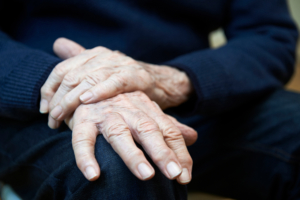Parkinson’s and Seating – What To Consider
Around 1 in 500 people are diagnosed with Parkinson's Disease with symptoms generally presenting after the age of 50.
The cause of Parkinson’s disease is not yet fully known, however both genetic and environmental factors are considered to be involved
Signs and Symptoms
Parkinson’s is a long-term and degenerative central nervous system disease that predominantly affects motor control although as it progresses can impact non-motor components such as cognition.
Typically, the disease presents with muscular rigidity and shaking which leads to movements becoming slower. This impacts on gait, increasing risks of falls particularly during the transition from sitting to standing as well as other aspects of daily life due to reduced fine motor skills and dexterity. Insomnia is a common symptom that contributes to other symptoms such as anxiety and depression.

Parkinson’s disease is caused by the death of specific neurons in the brain area called the substantia nigra. These nerve cells produce a substance called dopamine, which is therefore lacking in people with Parkinson’s disease.
Dopamine is a chemical that is responsible for the normal working of the part of the brain that controls movement. Dopamine deficiency leads to the following symptoms of the disease.
- Tremor, generally more pronounced whilst resting.
- Slowness of movement.
- Stiffness of movement, making initiating movement difficult.
- Impaired balance.
Seating
The disease is a degenerative condition which will present differently for everyone and as there is currently no cure symptoms are treated as and when they appear.
Due to the number of movement problems that Parkinson’s disease causes, including difficulty or delay of initiating movements, it can make getting comfortable in or rising from a chair difficult.
The movement from a sitting to a standing position is more complex than we often appreciate. It requires us to gain sufficient propulsion from a resting position to move forwards and then upwards out of the chair. Then follows the change in centre of gravity as we lean forward to generate initiation of movement. This movement requires a certain amount of force and speed, and difficulty or slowness initiating movement can result in insufficient momentum to rise from the chair and then mobilise safely.
In the early stages of the condition, strategies to improve position and momentum can help, such as moving first to the front of the seat, tucking the feet in under the knees and having the arms positioned to push up can help prepare a client to come forwards and upwards.
Rocking back and forth a few times before trying to rise can increase the momentum and force to continue the movement. Cuing your client (“ready, steady, stand”) can also help to prepare and initiate the movement.
As the condition deteriorates initiating movement can be so difficult or slow that standing even from a previously useable chair can be challenging. A chair with a rise function as part of its mechanism movements, such as the C-air, may provide extra support and propulsion which is perfect for helping to initiate standing. Most riser chairs work by slowly tilting and elevating the seat to lift and angle your pelvis forward. Sometimes just a small angle on the riser function is enough to initiate a natural stand. Otherwise, the seat angle can be elevated until you are almost in an upright position, allowing you to finish with a small stand and walk off from the chair. Due to the support being provided by the rise function it significantly reduces the risk of falls on initiating walking from the stand position.
In the later stages of the condition when the client finds it extremely difficult or impossible to move without carers support, considering comfort and the carer's abilities to work with the client to achieve the optimal position, comfort and movement is essential.
On assessment it is vital to consider a chair that can adjust with the clients changing ability and healthcare needs over time.
Considerations when looking for a suitable chair.
- The height of the seat must allow the user to sit with their feet flat on the floor. Always remember to ask whether a client uses slippers or not as this will affect height.
- The seat width needs to provide enough support to prevent a user slumping to either side in the chair.
- The seat depth should be long enough to support the femur, but not too long to cause pressure problems behind the knees.
- The armrest should be at a suitable height that supports a neutral resting position with no shoulder or shoulder girdle elevation. However, the height should consider the ergonomics of a stand and therefore create enough of an angle to support the upper limb push into standing.
- A motor that supports rising can facilitate a safe transition from sitting to standing whilst also providing a physical prompt to initiate movement and therefore reducing fall risks.
- The back should be high enough to support the upper limbs and avoid pressure points on the upper limbs large joints.
- The fabrics and any comfort padding should be discussed with the client to make sure it meets their needs.
Recommended seating
Below we have linked to some of the chairs in the Repose range that might be considered. Others in the range may be suitable, but this will depend on the clients conditions.
